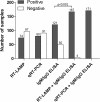Detection of dengue viruses using reverse transcription-loop-mediated isothermal amplification
- PMID: 23964963
- PMCID: PMC3846474
- DOI: 10.1186/1471-2334-13-387
Detection of dengue viruses using reverse transcription-loop-mediated isothermal amplification
Abstract
Background: Early and rapid detection of dengue virus (DENV) infection during the febrile period is crucial for proper patient management and prevention of disease spread. An easy to perform and highly sensitive method is needed for routine implementation especially in the resource-limited rural healthcare settings where dengue is endemic.
Methods: A single-tube reverse transcription-loop-mediated isothermal amplification (RT-LAMP) assay with a set of nine primers was developed for the detection of all four DENV serotypes and their different genotypes. The sensitivity and specificity of the RT-LAMP were evaluated. The clinical applicability of RT-LAMP assay for detection of DENV RNA was assessed in a total of 305 sera of clinically-suspected dengue patients. The test results of RT-LAMP were statistically compared to those of quantitative reverse transcription-polymerase chain reaction (qRT-PCR), IgM- and IgG-capture enzyme-linked immunosorbent assays (ELISA).
Results: Acute DENV infection was confirmed in 171 samples (n = 305); 43.3% (74/171) and 46.8% (80/171) of the samples were positive for DENV using RT-LAMP and qRT-PCR, respectively. The combination of RT-LAMP with the dengue IgM and IgG ELISA increased detection of acute DENV infection to 97.7% (167/171), in comparison to only 70.8% (121/171) when dengue IgM and IgG ELISA alone were used. The RT-LAMP assays showed high concordance (κ = 0.939) with the qRT-PCR. The RT-LAMP assay detected up to 10 copies of virus RNA within an hour but 100% reproducibility (12/12) was achieved with 100 copies. There was no cross reactivity of RT-LAMP with other closely related arboviruses.
Conclusion: The RT-LAMP assay developed in this study is sensitive, specific and simple to perform. The assay improved the detection of dengue when used in combination with serological methods.
Figures





References
Publication types
MeSH terms
Substances
LinkOut - more resources
Full Text Sources
Other Literature Sources
Medical

